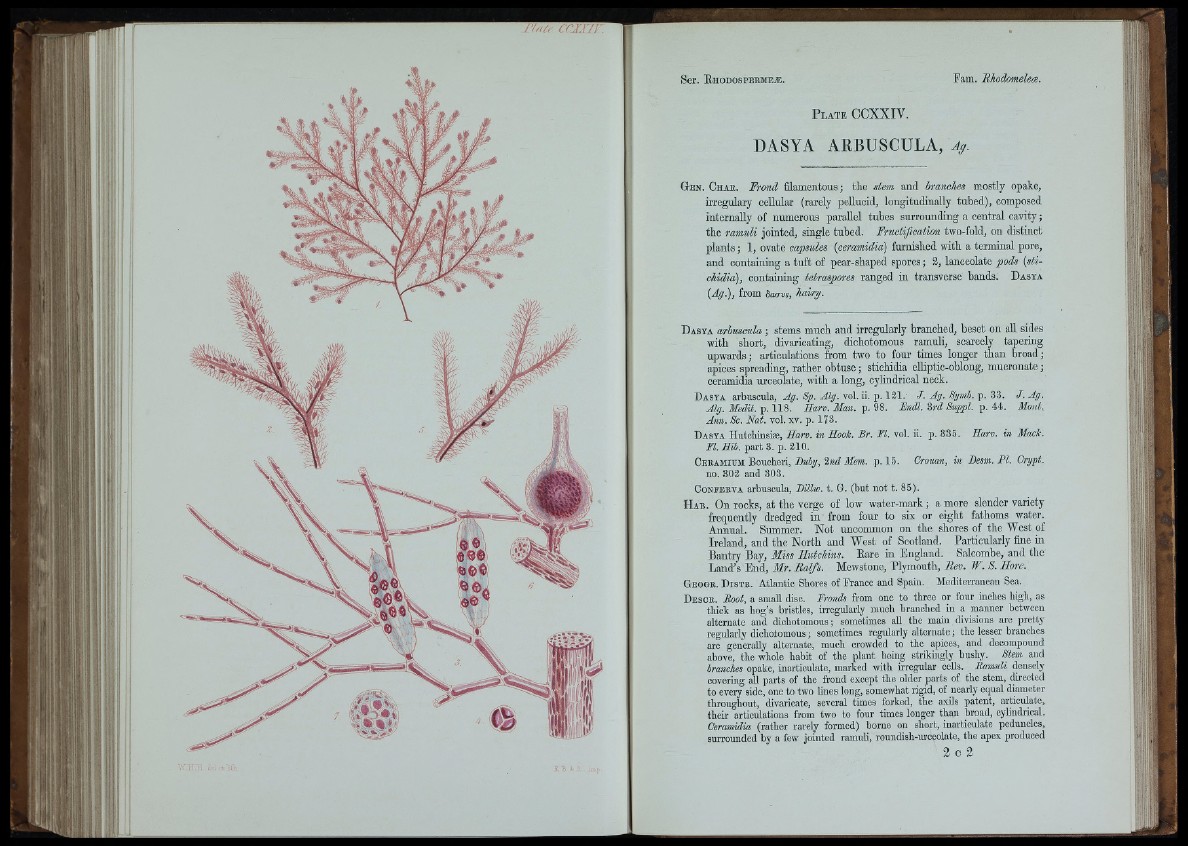
p fa ù - c r z r / v
II
if:
ri Ilf
V '- f
If
ü:
i
P la t e C C X X IV .
DASYA ARBUSCULA, Ag.
Gen. Char. Frond fllameiitous; the stem and branches mostly opake,
irregulary ceRular (rarely pellucid, longitudinally tubed), composed
internally of numerous p a raM tubes surrounding a central cavity;
the ramuli jointed, single tubed. Fructification two-fold, on distinct
p lants; 1, ovate capsules [ceramidia) furnished witb a terminal pore,
and containing a tuft of pear-shaped spores; 2, lanceolate pods {stichidia),
containing tetraspores ranged in transverse bands. D a sy a
{Ag.), from Satrvs. .
Dasya arbnscsda ; stems much and irregularly branched, beset on aU sides
with short, divaricating, dichotomous ramuli, scarcely tapering
upwards; articulations from two to four times longer than broad;
apices spreading, rather obtuse; sticbidia elliptic-oblong, muoronate;
ceramidia urceolate, with a long, cylindrical neck.
Dasya arbuscula, Ag. Sp. Alg. vol. ii. p. 121. J. Ag. Synib. p. 33. J. Ag.
Alg. Medit. p. 118. Harv. Man. p. 98. Endl. 3rd Suppl. p. 44. Mont.
Ann. Sc. Nat. vol. xv. p. 173.
Dasya Hutchinsiæ, Harv. in Hook. Br. El. vol. ii. p. 835. Harv. in Mack.
El. Hib. part 3. p. 210.
C e r a m i u m Boucheri, 2 » i f IT eoe . p. 1 5 . Crouan, in Besm. PI. Crypt.
no. 302 and 303.
C o n fe rv a arbuscula, Billw. t. G. (but not t. 8 5 ) .
Hab. On rocks, at the verge of low water-mark ; a more slender variety
frequently dredged in from four to six or eight fathoms water.
Annual. Summer. Not uncommon on the shores of the West of
Ireland, and the North and West of Scotland. Particularly fine in
Bantry Bay, Miss Hutchins. Rare in England. Salcombe, and the
Land’s End, M r. R a lfs . Mewstone, Plymouth, Rev. W. S. Hore.
Geogr. Distr. Atlantic Shores of France and Spain. Mediterranean Sea.
Descb. Boot, a small disc. Eronds from one to three or four inches high, as
thick as hog’s bristles, in-egularly much branched in a manner between
alternate and dichotomous ; sometimes all the main divisions are pretty
regularly dichotomous ; sometimes regularly alternate ; the lesser branches
are generally alternate, much crowded to the apices, and decompound
above, the whole habit of the plant being strikingly bushy. Stem and
branches opake, inarticulate, marked with irregular cells. Ramuli densely
covering all parts of the frond except the older parts of the stem, directed
to every side, one to two lines long, somewhat rigid, of nearly equal diameter
throughout, divaricate, several times forked, the axüs patent, articulate,
their articulations from two to four times longer than broad, cylindrical.
Ceramidia (rather rarely formed) borne on short, inarticulate peduncles,
surrounded by a few jointed ramnli, ronndish-urceolate, the apex produced
2 c 2
a
: